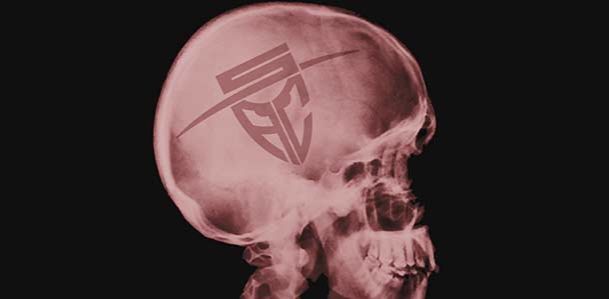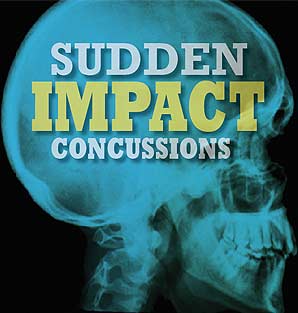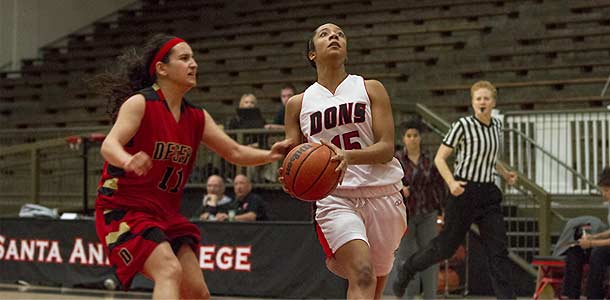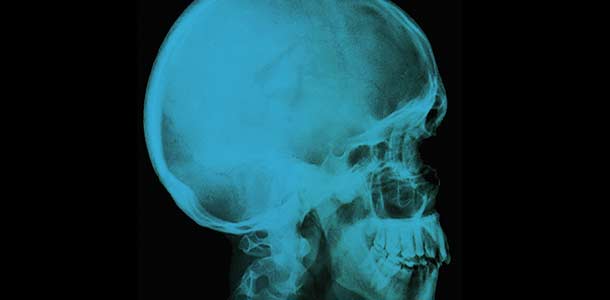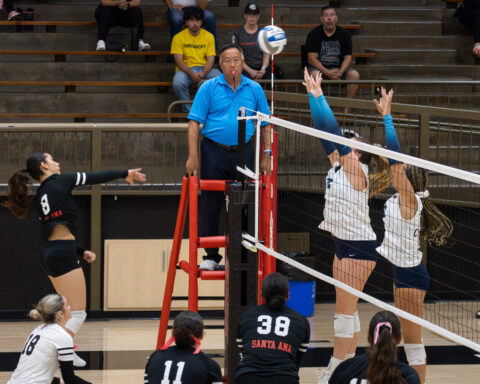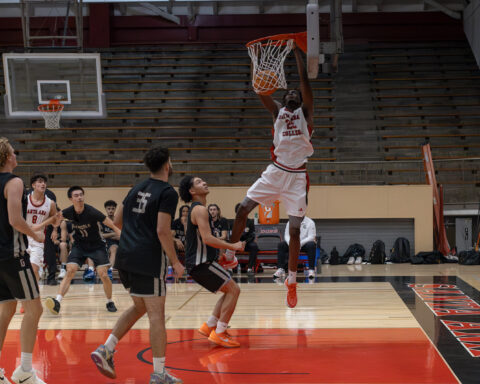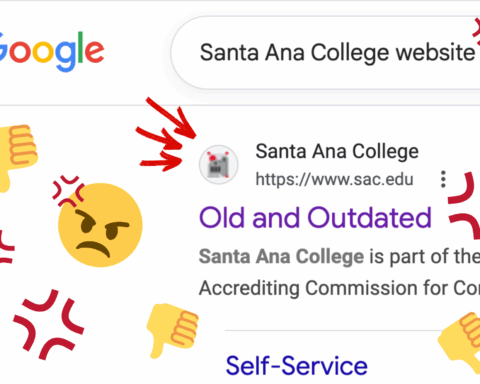Brain trauma and concussions are on the rise, with thousands affected yearly.
In a blur on the field, Defensive Back Chris Manassero felt the impact. He was stunned, saw a haze of color and blacked out. The 20-year-old safety started playing football in third grade, but had not suffered a concussion until that practice. Thinking nothing of it, Manassero shook it off until game day.
“I didn’t really know it was a concussion. I actually went into the game and that’s when I realized that I was still dizzy and in a daze,” Manassero said.
Concussions are more serious than just getting your bell rung. Manassero is one of thousands of college athletes who suffer brain injuries each year.
LONG-TERM HEALTH RISKS
Little is know about traumatic brain injuries, as serious study began in the 1980s. Terms like “PUNCH DRUNK” used to describe it.
At Santa Ana College, seven athletes have suffered concussions in the past two months. Five are football players. The other two are a soccer player and a volleyball player.
More than 450,000 sports-related brain injuries occur in the United States a year, according to the American Association of Neurological Surgeons.
Recent findings indicate a correlation between concussions and neurodegenerative diseases.
Former NFL players are three times more likely to develop brain disorders including Parkinson’s disease, and four times more likely to develop Alzheimer’s and Lou Gehrig’s disease, according to a study published by The National Institute for Occupational Safety and Health.
But contrary to popular belief, football players may not be the ones at the greatest risk, said Certified Athletic Trainer Nora Schug.
“A blow to the body can cause a concussion because the brain moves within the skull. Colliding with another player or getting hit with a leg or a limb are other ways. It’s not always a blow to the head that does it. It’s very common in soccer,” Schug said.
MORE THAN A HIT TO THE HEAD
Still, the rate of incidence in football is higher than other sports at SAC.
The NFL has taken notice of the high rate of concussions in its sport. In response, playing rules have been changed to remove unnecessary hits to the head in order to better protect players in speed and defenseless positions making the game safer, said Brian McCarthy, vice president of corporate communications for the NFL.
Trainers at SAC commend the NFL for changes to in-game policy.
“Those rule changes have been good in helping prevent concussions,” said Certified Athletic Trainer Gary Kinney.
“Coaches are getting smarter, knowing that it doesn’t help their players to play injured. If they’re hurt — get them out, get them fixed, get them back,” Kinney said.
Although SAC conforms to National Collegiate Athletic Association guidelines, sports programs have stayed in step with the NFL rule changes.
“The NCAA is a little more strict,” said Sports Information Coordinator Jason Kehler. “They now have a rule that if you lose your helmet, you have to treat it as an injury and come off the field. They’re really trying to make sure equipment is on and stays on and that players wear it properly.”
HAS THE NFL DONE ENOUGH?
But Head Football Coach Geoff Jones said the NFL should do more because of its influence.
“The NFL has done a good job trying to outlaw helmet-to-helmet injuries,” said Jones. “But if you’re not wearing a mouthpiece, then the percentage of getting a concussion goes way up. It’s the only shock absorber you have in your head. It’s such a simple fix, and I don’t see that in the NFL at all, and that’s where it trickles down from.”
Similarly, the NFL overly glorifies the “big hit” and the highlight reel, said Kehler, stressing that they must work to regulate bigger hits to create change at lower levels.
Crowds in Kansas City cheered Oct. 7, when Chiefs quarterback Matt Cassel was knocked out and sustained a concussion.
About 3,000 former players are suing the NFL on the basis that the league does not act in the best interest of the players and diminishes the importance of brain injuries, according to litigation papers filed by Locks Law Firm.
Winning at all costs is not a mentality that is appropriate in collegiate sports, Jones said.
“Some coaches take it too far. We definitely have different guys from all over the place with all kinds of philosophies and thoughts, and one of the things we have to do is retrain everybody,” Jones said.
When it comes to prevention, athletic trainers and coaches agree that education is key.
“Education is preventative. Concussions are very serious. They cannot be taken lightly, and they need to be dealt with properly so there are hopefully no long-lasting effects,” Schug said.
Chronic headaches, dizziness, long-term deficiencies and memory loss are among the issues that arise when concussions are ignored, said David Kruse, a certified sports medicine physician who specializes in concussions.
SAC has adopted a new concussion protocol. If a player shows a symptom of a concussion, they must undergo neurocognitive testing and will engage in physical activity at a slow and steady pace.
“Anytime we have any symptoms, they’re done for the day and they go straight to the training room to progress through the list. It’s state of the art, or as close as you can get,” Jones said.
FOOTBALL IS LIFE
A month after his concussion, Manassero stepped onto the field at LeBard Stadium before hundreds of spectators. He recorded five tackles for the Dons, leading to a win against the Orange Coast Pirates in overtime. For him, football is a way of life.
“If I can’t control it and get [concussions] all the time, I would rethink the safety, but it doesn’t really scare me too much,” Manassero said.
— Source: Sports Legacy Institude
Knowledge is key to preventing and treating head trauma. But what do we really know?
- 4 — out of five concussions suffered are not accompanied by loss of consciousness.
- 25 — recognized concussion symptoms, including fatigue, dizziness and light sensitivity.
- 1.7 — million people are hospitalized each year as a result of traumatic brain injuries. Only 25 percent are serious brain injuries.
[one_third]1 FREE FLOATING The brain is supported by spinal fluid in the skull, which causes it to move at a different rate than the skull in response to a collision.[/one_third]
[one_third]2 LINEMEN AT RISK In an average football season, players on the line may sustain up to 1,400 hits if they are only on one side of the ball.[/one_third]
[one_third_last]3BACK AND FORTH Coup-contrecoup TBI occurs when the head undergoes sudden stops. It is then injured at the point of impact and the opposite side.[/one_third_last]
[frame_left src=”http://www.eldonnews.org/wp-content/uploads/2013/09/image-Wide_Helmet-n-2-Brains1.jpg” href=”http://www.eldonnews.org/wp-content/uploads/2013/09/image-Wide_Helmet-n-2-Brains1.jpg”]Source and photos: Sports Legacy Institute[/frame_left]
DAZED AND CONFUSED
GEARING UP — In 2003, Schutt Sports introduced Thermoplastic Urethane Cushioning to football, the first advancement in over 30 years.
BRAIN DRAIN — The coronal section of a normal brain (left), showing the size and relationship of cerebral cortex and ventricles. The brain from a retired pro-football player (right)
- In Photos: Fiestas Patrias 2025 - September 25, 2025
- The two-party system is failing us. - October 19, 2024
- Read our Fall 2023 Print: Vol. 100 No. 1 - October 23, 2023


